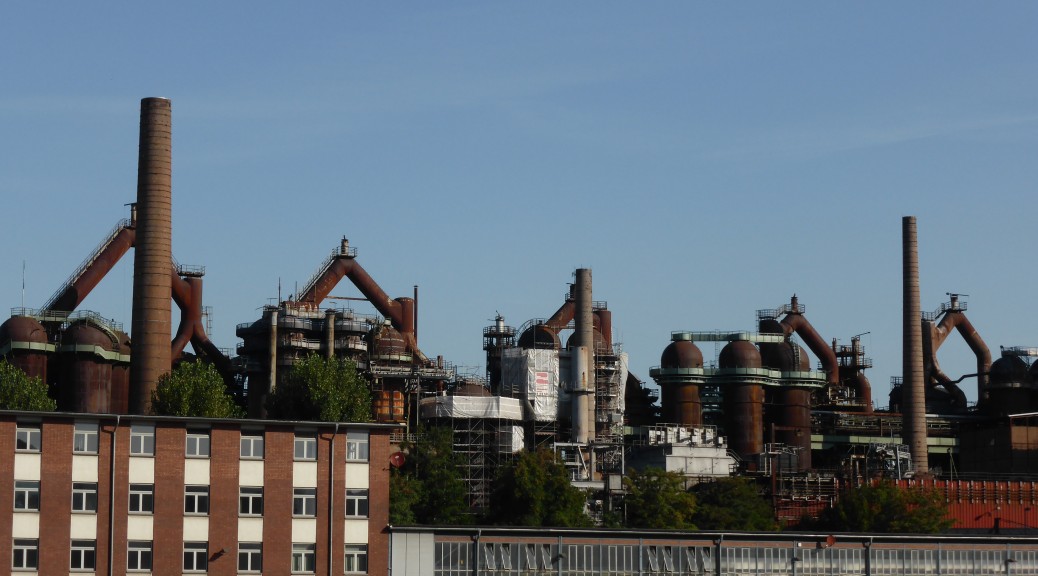Another leisurely start to the day, I was riding by nine. Descending out of the forest that sheltered me for the night, I headed south towards the French border – most of the day’s riding followed the rough outline of the border, just a few kilometres to the north. To start with it was quite chilly, but by about ten o’clock I had my fleece off (never to be seen again – I can’t for the life of me figure out where it has gone, it always goes in the same place in my bag) as there was a little bit of climbing to be done. The first part of the day was through reasonably open farm & cropping land – sometimes it was worth stopping to admire and take a picture.

Shortly after, I stopped to do the big battery changeover for the GPS – replacing the six now charged batteries, with the six empty ones that have powered my navigation for the previous day and a half. Except this time, the ones in the unit were not charged. This had happened before at the start, but as I got it all sorted eventually I assumed it was user error – this time definitely not. This led to quite a bit of time pondering how to sort all this out and get where I wanted to go. Thankfully, I keep some spares so I’m good for a day or two – but either I source a wall-charger & become more dependent on the grid, hope mine becomes a bit more reliable (not much chance), buy copious amounts of single-use AAs – or go without a GPS, but I do rather like knowing where I’m going and where I’ve been for future reference. It’s little problems like this, & losing one’s sweater, that become much bigger than they should when you are travelling solo and don’t have anyone to discuss them with… There was a big long downhill on off-road tracks that took me down to the bottom of the valley.
About a third of the way through the day’s riding, the terrain turned much more forested. I was still mostly on dedicated cycle paths and they seemed to following rivers, so any climbs weren’t strenuous and everything was pleasant. It is, however, difficult for me to take photos of riding through forests that capture just how nice it was – all you ever end up seeing is some trees and the mood is not conveyed at all. With one little climb after lunch at a beer garden – which while the beer was cheap, didn’t really serve food, oops – the rest of the day was also pretty easy.

 Mention must be made of firewood stacks – they’re everywhere out here and some of them really are quite large.
Mention must be made of firewood stacks – they’re everywhere out here and some of them really are quite large.
I’d previously decided that I’d find a hotel in Wissembourg so that I could get organised for the TransVosges route – which would probably be four or five days of riding (from what I could tell by looking at the elevation profile & distance). As a wiser person than I mused, bikepacking might not be all that fun for him as the performance of the bike would suffer and take away from the enjoyment of the riding. With my experiences so far, while the exploring facet of my trip has been great, the mountain-biking in the purest sense has not got me excited. Plus, once again, being solo, the prospect of four or five days without anyone to share the highs or lows of such a big route with is just too much. Add in that doing the TransVosges would greatly increase the chance of me spending my birthday alone – any desire to head to the hills just now has gone. I must have got this all wrong – I’m not quite cycle touring and I can’t quite get this solo-bikepacking thing to work.
The fool in me thinks everything will be OK once I get to Italy and I can at least hold a halting conversation in the local language. But, not being the most outgoing of people, I’d really have to force myself to engage a bit more – which may be a bit drastic or require drastic steps! But as it is, I’m tired of just passing through seeing really nice places and not having any real sense of what is happening in said places. Anyway, I’ll head to Strasbourg, which I’ve wanted to see for a while and then work out the best way to get to Italy – proabably train to Turin.
Wissembourg surprised me, which wasn’t hard as I knew nothing of it, by being very pretty – perhaps the prettiest town I’ve seen yet on this trip. In the Alsace region (here comes WWII history classes again) there is a fair bit of Maginot Line history around, so that interests me. I wandered around the delightful streets in the late afternoon sun, had my first gelato of the trip & yet couldn’t really shake the malaise. After catching up on the mammoth photo dump for the previous post I tried to order my dinner in Italian at Pizzeria Chianti – but the French proprietor wasn’t having any of that!












































